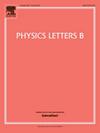Topological diagram analysis of Bc3‾→B10M decays in the SU(3)F limit and beyond
IF 4.3
2区 物理与天体物理
Q1 ASTRONOMY & ASTROPHYSICS
引用次数: 0
Abstract
Charm baryon decay plays an important role in studying non-perturbative baryonic transitions. Compared to other hadron multiplets, the flavor symmetry of baryon decuplet is more simple and attractive. In this work, we study the topological amplitudes of charmed baryon decays into decuplet baryon in the flavor symmetry and the linear breaking. It is found most of topological diagrams are suppressed by the Körner-Pati-Woo theorem in the limit. Only two independent amplitudes contributing to the decays, with one dominating the branching fractions. The Lee-Yang parameters of all modes are the same in the limit, and there are only four possible values for the CP asymmetries. After including the first-order breaking effects, the and decays have non-zero branching fractions. The number of free parameter contributing to the decays in the linear breaking is smaller than the available data. The breaking part of the quark loop diagram can be extracted by global fitting of branching fractions, which could help us understand the CP violation in charm sector. Additionally, some new isospin equations are proposed to test the Körner-Pati-Woo theorem.
SU(3)F极限及之后[式略]衰变的拓扑图分析
魅力重子衰变在研究非微扰重子跃迁方面发挥着重要作用。与其他强子多子相比,粲重子衰变的味道对称性更简单、更有吸引力。在这项工作中,我们研究了在味道对称和线性SU(3)F破缺的情况下,粲重子衰变成小重子的拓扑振幅。研究发现,在 SU(3)F 极限,大多数拓扑图都被柯尔纳-帕蒂-沃定理所抑制。Bc3‾→B10M衰变只有两个独立的振幅,其中一个主导着分支分数。在SU(3)F极限中,所有Bc3‾→B10M模式的李-杨参数都是相同的,CP不对称也只有四种可能的值。在包括一阶 SU(3)F 破缺效应之后,Ξc+→Σ⁎+K‾0 和Ξc+→Ξ⁎0π+ 衰变的分支分数都不为零。在线性SU(3)F破缺中,对Bc3‾→B10M衰变有贡献的自由参数数量小于现有数据。夸克环图的SU(3)F破缺部分可以通过支化分数的全局拟合来提取,这有助于我们理解符部门的CP违反。此外,我们还提出了一些新的等空间方程来检验柯尔纳-帕蒂-沃定理。
本文章由计算机程序翻译,如有差异,请以英文原文为准。
求助全文
约1分钟内获得全文
求助全文
来源期刊

Physics Letters B
物理-物理:综合
CiteScore
9.10
自引率
6.80%
发文量
647
审稿时长
3 months
期刊介绍:
Physics Letters B ensures the rapid publication of important new results in particle physics, nuclear physics and cosmology. Specialized editors are responsible for contributions in experimental nuclear physics, theoretical nuclear physics, experimental high-energy physics, theoretical high-energy physics, and astrophysics.
 求助内容:
求助内容: 应助结果提醒方式:
应助结果提醒方式:


